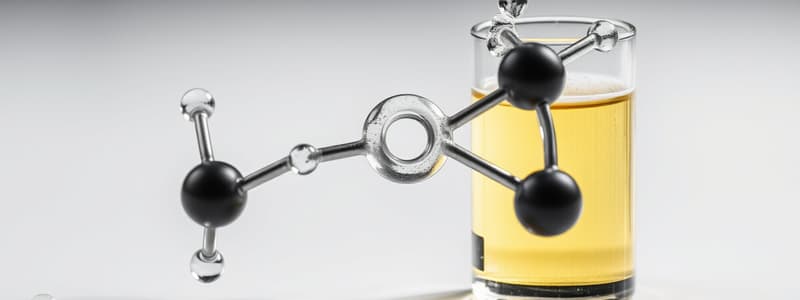Podcast
Questions and Answers
What intermolecular forces exist between molecules of ethanol?
What intermolecular forces exist between molecules of ethanol?
- London dispersion forces
- Dipole-dipole interactions
- Hydrogen bonding
- All of the above (correct)
What intermolecular forces exist between molecules of dimethyl ether?
What intermolecular forces exist between molecules of dimethyl ether?
- London dispersion forces (correct)
- Dipole-dipole interactions (correct)
- Hydrogen bonding
- None of the above
What is osmosis?
What is osmosis?
The spontaneous migration of water through a semipermeable membrane from high concentration of water (low solute) to low concentration of water.
What is a semipermeable membrane?
What is a semipermeable membrane?
What describes a hypertonic solution?
What describes a hypertonic solution?
What is an isotonic solution?
What is an isotonic solution?
What characterizes a hypotonic solution?
What characterizes a hypotonic solution?
What is osmotic pressure?
What is osmotic pressure?
In the equation pi = MRT, what does M represent?
In the equation pi = MRT, what does M represent?
What are colligative properties?
What are colligative properties?
What does the van't Hoff factor indicate?
What does the van't Hoff factor indicate?
Match the following terms with their definitions:
Match the following terms with their definitions:
A pseudo-first-order reaction occurs when all the reactants but one are present at low concentrations.
A pseudo-first-order reaction occurs when all the reactants but one are present at low concentrations.
What is activation energy (Ea)?
What is activation energy (Ea)?
What is the Clausius-Clapeyron equation used for?
What is the Clausius-Clapeyron equation used for?
What describes the transition state in a chemical reaction?
What describes the transition state in a chemical reaction?
What determines the reaction order?
What determines the reaction order?
What is the rate constant?
What is the rate constant?
What does the rate law express?
What does the rate law express?
Flashcards are hidden until you start studying
Study Notes
Intermolecular Forces
- Ethanol exhibits London dispersion forces, dipole-dipole interactions, and hydrogen bonding.
- Dimethyl ether shows London dispersion forces and dipole-dipole interactions.
Osmosis and Membranes
- Osmosis involves water moving through a semipermeable membrane from high to low water concentration.
- A semipermeable membrane allows water to flow but restricts hydrated particles.
Tonicity of Solutions
- Hypertonic solutions have a higher solute concentration than red blood cells, leading to cell shrinkage.
- Isotonic solutions match solute concentrations in cells, resulting in no net osmotic flow.
- Hypotonic solutions have a lower solute concentration than cells, causing cells to expand.
Osmotic Pressure
- Osmotic pressure prevents water from moving across a membrane due to concentration differences.
- The formula for osmotic pressure is π = iMRT, where i is the van't Hoff factor, M is molarity, R is the gas constant, and T is the temperature.
Colligative Properties
- Colligative properties rely on particle concentration rather than the identity of the solute.
- Van't Hoff factors indicate actual particle count in solution versus theoretical counts if no dissociation occurs.
Desalination and Water Purification
- Desalination removes ions from seawater through methods like distillation and reverse osmosis.
Vapor Pressure and Volatility
- Vapor pressure reflects the extent to which a gas is in equilibrium with its liquid phase.
- Volatility is associated with higher vapor pressures; more volatile substances evaporate easily.
Thermodynamics and Energy
- Spontaneous processes occur without external intervention, while non-spontaneous processes require energy input.
- The second law of thermodynamics states total entropy in the universe increases with spontaneous reactions.
- Third law: Entropy of a perfect crystal is zero at absolute zero temperature.
Gibbs Free Energy
- Gibbs free energy measures work capability of thermodynamic systems; G = H - TS, where H is enthalpy, T is temperature, and S is entropy.
Photochemical Smog
- Formed from sunlight reacting with pollutants from combustion engines, combining gases and particles.
Chemical Kinetics
- Chemical kinetics studies reaction rates and concentration changes during reactions.
- Factors influencing reaction rates include concentration, temperature, and presence of catalysts.
Rate Laws and Reaction Orders
- Rate laws describe the relationship between concentration and reaction rate: rate = k[A]^m[B]^n, where k is the rate constant.
- Overall reaction order is the sum of exponents in the rate law.
Half-Life and Reaction Mechanics
- Half-life (t1/2) is the time for a reactant's concentration to decrease by half; inversely related to reaction rate.
- Pseudo-first-order reactions occur when one reactant is in excess concentration.
Activation Energy
- Activation energy (Ea) is the minimum energy required for molecules to react during collisions.
- Increasing temperature raises reaction rates.
Catalysts
- Catalysts are substances that increase reaction rates without being consumed, lowering activation energy.
- Homogeneous catalysts share a phase with reactants, whereas heterogeneous catalysts exist in a different phase.
Studying That Suits You
Use AI to generate personalized quizzes and flashcards to suit your learning preferences.



